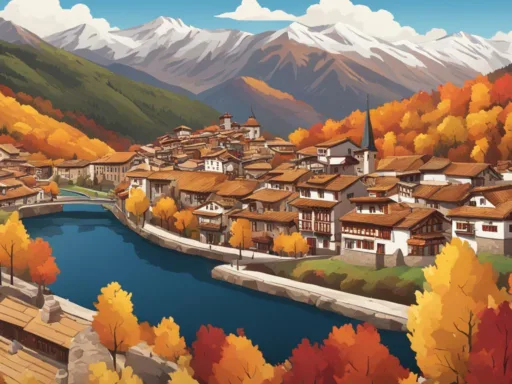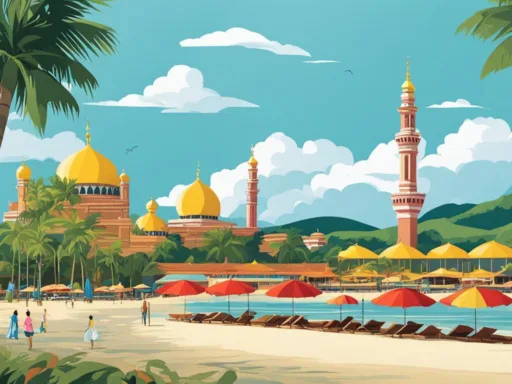If you’re seeking the quintessence of an undiscovered paradise, you might wonder, what’s the Best Time to Visit Nauru? As the world’s smallest island nation, this remote gem beckons with its balmy breezes and pristine beaches. Yet, knowing when to embark on your Nauru travel season could be the difference between a good holiday and an extraordinary retreat. So, have you ever pondered upon the ideal time for a Nauru trip to unlock the full potential of Pacific Island splendor?
Nauru’s allure is no accident. This ‘Pleasant Island’ is edged with coral reefs and a verdant inland that tells a tale far beyond its idyllic shores. Finding that perfect intersection of climate and culture will enrich your dream of the ultimate Pacific escape.
Key Takeaways
- Identify the ideal travel season for perfect weather and cultural experiences in Nauru.
- Understand the climate nuances that make Nauru a year-round destination.
- Plan your visit to enjoy both the tranquility and the festive cultural heritage of the island.
- Discover how a well-timed trip maximizes outdoor activities and sightseeing in Nauru.
- Learn about the environmental and historical facets shaping Nauru’s travel recommendations.
Unveiling Nauru: A Hidden Gem in the Pacific
Amidst the vast expanse of the South Pacific Ocean lies Nauru, a sovereign island country that sparks the curiosity of many travelers with its seclusion and pristine charm. Enveloped by the embrace of the cerulean sea, Nauru’s rich tapestry weaves together the stories of its original inhabitants, marauding European explorers, and the consequential boom of the phosphate mining era. This juxtaposition of history and natural allure sets the stage for a travel experience that remains virtually untouched by the tourism industry’s heavy hand.
For those pondering Nauru vacation timing, it’s essential to consider how this enclave’s Nauru climate tips can shape your stay. Infrequent travelers bask in an environment that’s both tranquil and intimate, as Nauru’s absence of crowds allows for unhurried exploration and relaxation. With an allure that resides in its simplicity, it is vital to acknowledge that a visit here is unlike the standard beachside holiday—it’s an immersion into an environment where time moves differently and the authenticity of the island reverberates throughout your journey.
Nauru Sightseeing Season: To fully embrace Nauru’s offerings, aligning your visit during the Nauru sightseeing season will maximize your experience of this Pacific haven. Ideal timing intertwines with island events and activities that flourish in seasons, each with its unique characteristics—a guide to identifying your perfect getaway timeframe.
| Month | Climate Considerations | Recommended Activities |
|---|---|---|
| May – October | Driest season, optimal for outdoor adventures | Beach outings, historical tours, cultural festivals |
| November – February | Wet season, lush landscapes, occasional downpours | Witnessing the island’s vegetation flourish, indoor cultural explorations |
| March – April | Transitional period with moderate rainfall | Bird watching, snorkeling, engaging with local communities |
Remember, while the smaller scale of infrastructure on Nauru may demand more meticulous planning, it’s this very element that upholds the island’s unique charm. Whether it’s a venture through history or a surrender to the slow-moving ripples of Pacific island life, Nauru welcomes those with a heart for adventure and a penchant for the path less traveled.
Nauru’s Climatic Bliss: Navigating the Tropical Weather
As a shimmering Pacific getaway, Nauru’s consistent climate presents an enviable slice of heaven for visitors seeking an eternal summer vibe. This slice of paradise features pristine beaches and an escape from the hustle and bustle of crowded tourist destinations.
Temperature Trends and What to Expect
For those gearing up to explore the 4 square miles of Nauru’s enchanting landscape, the island’s weather facilitates year-round beach activities. The infamous Pacific sun blankets the island, making the Nauru weather guide a predictable friend for travelers. Average temperatures gracefully sway around a balmy 30°C (86°F), presenting an inviting scene for those wishing to lounge on the sands or plunge into the inviting blue waters.
Handling Rainy Season: Travel Tips
While sun-seekers revel in Nauru’s warmth, the rainy season paints the island with a different brush of beauty. The months of November through February may present an occasional downpour, but these showers only serve to heighten the island’s flourishing greenery. Travelers can thus experience a vividly refreshed landscape, punctuated by clear, sparkling skies post-rainfall.
Here’s a quick guide to enjoying Nauru during the wetter months:
- Prepare for sporadic showers, as rainfall can be heavy but usually brief.
- Focus on indoor cultural experiences or museum visits during rain spells.
- Enjoy the dramatic scenery and cooler air after a thunderstorm.
- Partake in water-based activities in the warm sea, as the water temperature remains pleasant.
Cyclones rarely cast a shadow over Nauru, ensuring that this Pacific haven remains a year-round destination for the intrepid and serene alike. So whether you’re planning to soak in the sun or experience the freshness that comes with tropical rains, your Nauru itinerary will be as diverse as the island itself.
Best Time to Visit Nauru
Discovering the ideal period for a visit to the world’s smallest island nation involves considering Nauru’s climatic patterns and cultural calendar. Whether you’re searching for perfect beach weather or looking to engage with local festivals, timing your journey to this Pacific haven can enhance your travel experience significantly.
Ideal Months for Optimal Weather
For those aiming to bask under the Pacific sun, the best time to visit Nauru is typically from May through October. During this span, dry and sunny days prevail, creating idyllic conditions for outdoor adventures and water-centered activities. The clear, pleasant weather invites travelers to soak in the serene beauty of Nauru’s pristine beaches and vibrant coral reefs.
Off-Peak Periods for Tranquil Exploration
The allure of Nauru extends beyond its Nauru travel season. Venturing to the island during the off-peak months presents an opportunity for tranquil exploration, where the serene environment is complemented by a slower pace and fewer tourists. This time allows for a more personal journey, offering intimate interactions with the island’s welcoming population and undisturbed discovery of its natural splendors.
Nauru’s Cultural Events and Festivities
Nauru may be small, but its cultural heartbeat is strong. Visiting during local events and festivities can immerse you in the island’s traditions and vibrant community life. One such occasion is Independence Day on January 31, a symbol of Nauru’s resilient spirit, making it a time of great national pride and celebration. Participating in these cultural moments provides an enriching dimension to your Pacific getaway.
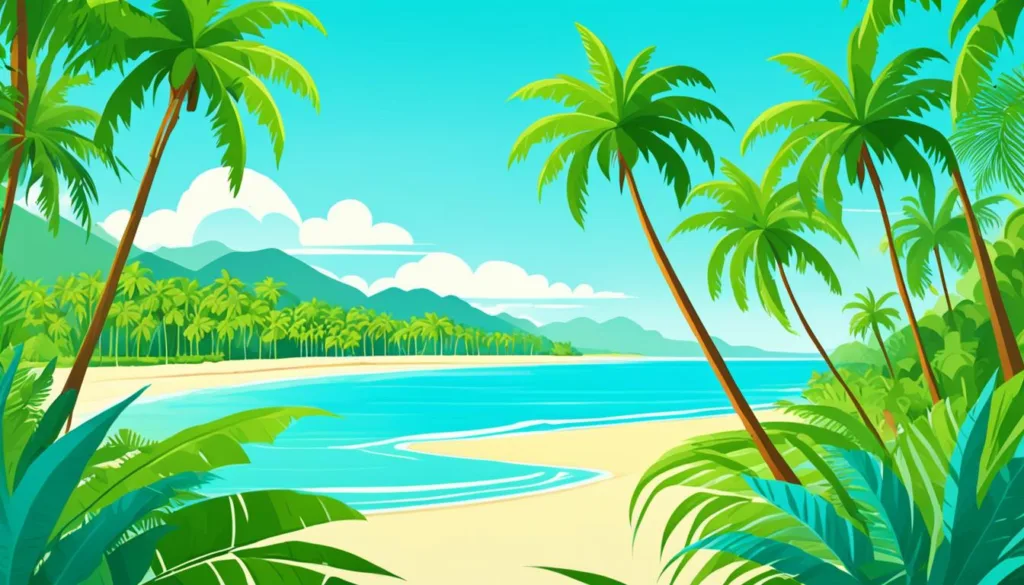
Exploring the Island’s History: A Glimpse into the Past
The tapestry of Nauru history is painted with the hues of resilience and the shadows of a colonial legacy that profoundly shaped the island nation. Before the lure of the phosphate industry drew international attention, Nauru flourished with an indigenous lifestyle in harmony with the surrounding sea and land.
In a remarkable yet tumultuous historical transition, Nauru experienced explosive economic growth fueled by the discovery of phosphate, a valuable mineral resource. However, this windfall soon fell prey to the exploitation by colonial powers. Let’s delve into a pivotal segment of this era—examining the international tug-of-war over Nauru’s phosphate wealth.
- German Annexation and the League of Nations Mandate
- British, Australian, and New Zealand Co-Administration
- World War II Occupation and the Trust Territory
- Independence and Economic Uncertainty
As independence dawned in 1968, Nauru faced the daunting task of navigating the aftermath of its phosphate-driven economy. The legacy of exploitation left environmental scars and an uncertain path towards sustainable development. Reflecting on Nauru’s path to sovereignty, we acknowledge both the struggles and the fortitude of its people.
“The history of Nauru is a clarion call to understand the complexities of a small nation grappling with the allure and dangers of its natural resources.” — Nauruan Scholar
| Colonial Power | Years Active | Impact |
|---|---|---|
| Germany | 1888–1914 | Initial annexation and commencement of phosphate mining |
| League of Nations Mandate (Administered by Britain, Australia, and New Zealand) | 1920–1947 | Intensified extraction of phosphate, with minimal returns to the local population |
| Trust Territory (United Nations Trust under Australia, New Zealand, and UK) | 1947–1968 | Laid groundwork for independence while continuing phosphate exportation |
Nauru Tourism Peak: Scheduling Your Island Adventure
While Nauru might not top global tourism charts, it sees a distinct uptick in visitors during the Nauru tourism peak season. This period from May to October aligns with some of the most favorable weather conditions on the island, making it an ideal time for tourists looking for a Pacific getaway. Not only does the sun seem to shine brighter during these months, but the opportunity to engage in both land and sea activities becomes more appealing. As a dedicated travel planner, marking the calendar for these dates is paramount to experiencing Nauru at its finest.
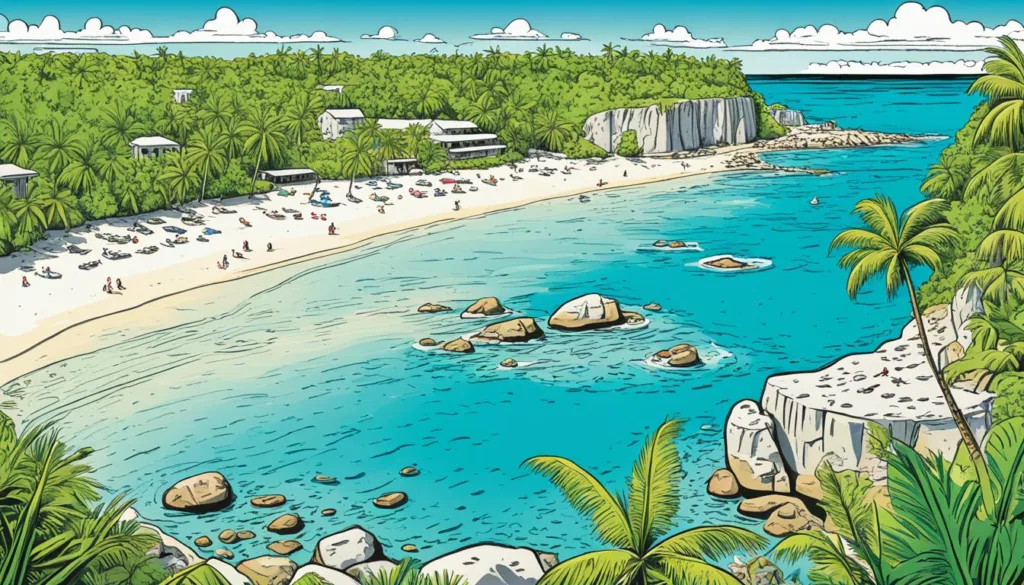
Seasonal Visitor Influx and Accommodations
Given that the number of lodgings in Nauru is limited, securing accommodation during peak season requires forethought and swift action. Rooms quickly fill up with eco-conscious travelers and those seeking cultural immersion. To assist in the planning process, below is a comparative table of available accommodations, outlining key details to consider when booking your stay.
| Hotel | Peak Season Availability | Rate (Per Night) | Eco-friendly Practices |
|---|---|---|---|
| Menen Hotel | Limited | $150 | Solar-powered water heating |
| Od’n Aiwo Hotel | Moderate | $130 | Recycling program |
| Anibare Bay Apartments | High | $120 | Energy efficient lighting |
Explorers must take action 7 months in advance to book a spot during Nauru’s high season to secure not just the best rates but also a commitment toward sustainability. This advanced planning allows ample time for amending itineraries in case of limited room options or unexpected changes in availability.
Sustainable Tourism and Cultural Experiences
Nauru takes great pride in its budding thrust towards sustainable tourism, aiming to protect its pristine environment while offering genuine cultural experiences. Travelers are often drawn to the chance of meaningful engagement with local customs, participating in traditional activities, and contributing to the conservation of Nauru’s ecosystems. The move toward eco-tourism not only enhances the travel experience but also supports Nauru’s long-term viability as a tourism destination.
- Eco Tours & Nature Walks – Learn about indigenous plants and wildlife conservation.
- Cultural Workshops – Participate in weaving, local crafts, and cooking lessons.
- Homestays with Nauruan Families – Immerse yourself in the day-to-day island life.
Acting as your own travel planner for an island adventure calls for a balance between seizing the cultural riches of a destination and preserving its natural and societal integrity. When visiting during the Nauru tourism peak, your mindful presence becomes a part of the island’s enduring story.
Adventure Awaits: Activities and Sightseeing in Nauru
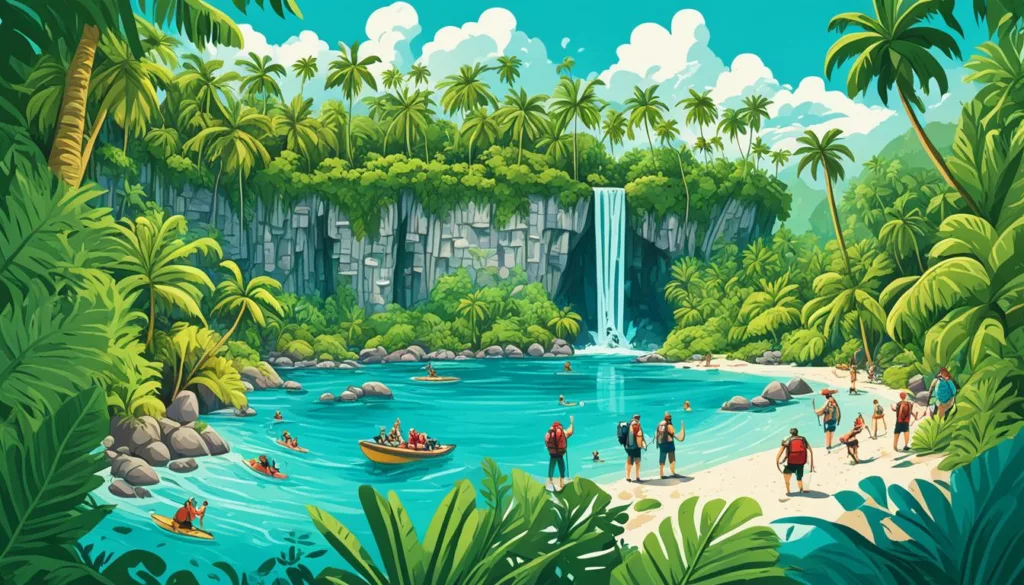
The tiny island of Nauru may not feature on every traveler’s map, but for those in the know, it is a treasure trove of Nauru activities and unforgettable experiences. Here, the call of adventure rings as loud as the ocean waves crashing onto its sunny shores. Embark on an island adventure that whisks you away to the days of old, contrasts starkly against the relics of industry, and plunges you into a world of tropical exploration.
Dive enthusiasts are in for a treat with Nauru’s crystal-clear waters, providing an excellent setting for underwater adventures. Equally compelling is the interior of the island; its rough, untouched terrain beckons the explorer within. Marvel at the juxtaposition of beauty and history while wandering through relics from bygone eras, notably poignant remnants from World War II and the intensive phosphate mining period. Such sights offer a poignant reminder of the island’s complex past, adding depth to your journey.
Those with a penchant for natural beauty will appreciate the island’s bird watching opportunities, joining the rank of eco-conscious visitors eager to glimpse the local avian life. Fishing, too, has a particular allure in Nauru—whether it’s part of a guided expedition or a leisurely endeavor with locals, it’s a cultural and recreational highlight not to be missed.
And for some, the ultimate enjoyment lies in a simpler pleasure: relaxing on the edge of the Pacific, where the sun’s warm embrace and the gentle rhythm of the waves create a harmonious backdrop. Whether you’re seeking adrenaline-spiking activities or the calming pace of island life, Nauru caters to all in its own unique, enchanting way.
Nauru’s Unique Biodiversity: When Nature Calls
As the smallest island nation on Earth, Nauru remains a sanctuary for biodiversity, inviting those with a passion for wildlife watching to explore its unspoiled habitats. Its compact size belies the resilience of its ecosystems, which have withstood the island’s tumultuous history. Visitors are rewarded with glimpses of an environment seldom touched by the rapid development that characterizes other regions, a true testament to Nauru’s unique biodiversity.
Wildlife Watching in Nauru’s Unspoiled Habitats
In the undisturbed corners of the island, where the land has escaped the reach of phosphate mining, nature thrives in quiet defiance. This is where wildlife watching becomes a particularly evocative experience. Bird enthusiasts can revel in the sights and sounds of the Nauruan sky, alive with species like the Noddy and the White Tern. These avian wonders complement the stark beauty of the island’s landscapes—a rarity in today’s world of rampant habitat destruction.
The Environmental Legacy: Preserving Nauru’s Natural Beauty
Moving towards preserving Nauru’s natural beauty, concerted efforts are underway to rehabilitate landscapes affected by decades of phosphate extraction. It’s not just about nurturing lost vegetation; it’s about securing a future where Nauru’s environmental legacy is one of regeneration and renewal. For Nauruans and visitors alike, the charge to preserve the island’s flora and fauna is also a call to support its continued existence as a place where nature can be appreciated as it has for millennia.
Conclusion
For the thoughtful traveler keen on crafting a memorable journey, Nauru stands out as an intimate Pacific getaway. This serene island gifts its visitors with an extraordinary palette of pristine beaches, a rich tapestry of cultural sights, and the engaging narratives of a spirited community. A Nauru travel planner is more than just an organizer of trips; it’s a gateway to the tapestries of an island teeming with tranquil beauty and vibrant heritage.
From the consistent caress of tropical warmth to the charm of local festivities, Nauru’s allure lies in its capacity to deliver experiences as untouched and genuine as its landscapes. For those plotting their island passage, timing is key – and the months between May and October present that golden window to absorb Nauru’s sunlit splendor. Yet, even beyond this season, the island woos the variegated inclinations of explorers, offering both lush rainy respites and unparalleled communion with nature and culture alike.
As a testament to humanity’s tenacity, Nauru invites the world to witness a story rich with endurance and revival. Its compact shores are a warm embrace, a nexus of natural beauty and historical depth poised for discovery. Whether seeking a sanctuary from the bustle of daily life or the thrill of untamed terrain, Nauru is poised to etch indelible memories in the hearts of its visitors. Thus, discerning adventurers will find in Nauru an unparalleled fusion of history, hospitality, and harmony – a true gem cradled in the vastness of the Pacific.



